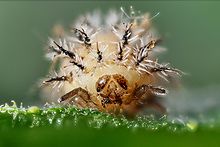Bryony Ladybug
| Bryony Ladybug | ||||||||||||
|---|---|---|---|---|---|---|---|---|---|---|---|---|

Bryony Ladybird ( Henosepilachna ) |
||||||||||||
| Systematics | ||||||||||||
|
||||||||||||
| Scientific name | ||||||||||||
| Henosepilachna argus | ||||||||||||
| ( Geoffroy , 1762) |
The beetle ladybird ( Henosepilachna argus ) is a beetle from the ladybird family (Coccinellidae).
description
The beetles grow to be six to eight millimeters long. The rounded wings are strongly arched. Its body is completely orange to orange-red from head to toe and has 12 black, sharply defined points on the wings. The shield spots colliding on the wings form a double spot , which is why it was sometimes incorrectly referred to as the eleven-point ladybug .
The wings are densely covered with fine, short hairs, but they can hardly be seen with the naked eye. This hairiness makes the surface of the beetle look matt, while it is smooth and shiny in similar species.
Occurrence
The bryony ladybug is common in North Africa, Asia Minor, and Europe. It occurs in Central Europe only in the warm areas. In Germany it is limited to the southwestern federal states. Its range has increased northwards in the past few decades. It was also registered in northern France as far as the English Channel and in the eastern provinces of Belgium when an inventory of species was carried out in 2007. Climate change is considered to be the cause of the spread . In Great Britain it did not appear until the first decade of the 21st century. It was probably introduced there with cultivated plants.
The beetles live mainly on bryony ( Bryonia ) and other cucurbits such as melons , whose leaves they feed on. They are also close to the areas of their host plants on hedges, fallow land, forest clearings and in some cases even to be found in the dunes.
Way of life
food
The bryony ladybird is one of the ladybirds that do not feed on aphids or other insects, but specialize in plant food. The beetles eat the leaves of the cucurbits down to the veins , the larvae only feed on the top layer of the leaves. In Central and Northwestern Europe they are mainly found on the red fruit and the white bryony , in the south on the leaves of various types of melons.
Reproduction
The beetle ladybugs appear in spring and are active until the end of summer. Their life cycle is synchronized with that of their host plants. Then the beetles hibernate. They mate in spring. The yellow colored eggs are laid on the underside of the leaves of the host plants. The eggs of the beetle ladybird occupy a special position because of their shape. They are drawn out into a conical tip. Like all eggs of the subfamily Epilachninae, they have a special surface structure (chorionic sculpture). The larvae hatch after around 12 to 14 days.
Individual evidence
- ↑ Brown beetle ladybird at www.insektenbox.de (accessed on June 20, 2010)
- ^ W. Wittsack: On the distribution and spread of Hanosepilachna argus (Geoffroy) (Col., Coccinnelidae) in the GDR. Entomologische Nachrichten, 21, pp. 1-7, 1977
- ↑ British Wildlife Magazine . Volume 16, p. 286, British Wildlife Publishing, 2004
- ^ Y. Le Monnier and A. Livory: Une enquête Manche-Nature: Atlas des Coccinelles de la Manche. Les Dossiers de Manche-Nature 5, 2003
- ^ Bernhard Klausnitzer and Hertha Klausnitzer: Ladybirds (Coccinellidae). Ziemsen, 1979 p. 36
literature
- Heinz Joy, Karl Wilhelm Harde, Gustav Adolf Lohse: The beetles of Central Europe. Clavicornia. 1st edition, Spektrum Akademischer Verlag, 1967, p. 233
- W. Kühnelt: The penetration of a herbivorous ladybird ( Epilachna argus Geoffr.) Into the Vienna basin.- Sbe. math.-nat.wiss. Class east Akad. Wiss. Vienna 190 (1981): 161-172
Web links
- Henosepilachna argus at Fauna Europaea
- Bryony Ladybird Wanted poster at Insektenbox.de
- Bryony Ladybird - Henosepilachna argus Pictures of eggs, larvae, pupae and beetles at Wild about Britain
- Photo at Hlasek.com
- Photo at Koleopterologie.de
